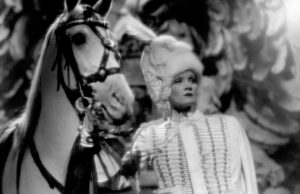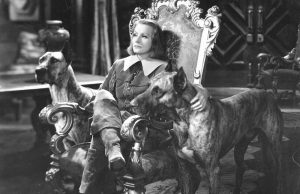Five Came Back (1939)
By Toronto Film Society on January 16, 2019
Toronto Film Society presented Five Came Back (1939) on Monday, January 14, 2019 in a double bill with Escape as part of the Season 71 Monday Evening Film Buff Series, Programme 4.
Production Company: RKO Radio Pictures. Producer: Robert Sisk. Director: John Farrow. Screenplay: Nathanael West, Jerome, Cady and Dalton Trumbo, story by Richard Carroll. Music: Roy Webb. Cinematography: Nicholas Musuraca. Release Date: June 23, 1939.
Cast: Chester Morris (Bill), Lucille Ball (Peggy Nolan), Wendy Barrie (Alice Melhorne), John Carradine (Crimp), Allen Jenkins (Pete), Joseph Calleia (Vasquez), C. Aubrey Smith (Prof. Henry Spengler), Kent Taylor (Joe Brooks), Patric Knowles (Judson Ellis), Elisabeth Risdon (Martha Spengler), Casey Johnson (Tommy Mulvaney), Dick Hogan (Larry).

Author Nathanael West, who had just published his searing novel about Hollywood, “The Day of the Locust”, joined RKO in 1939 and was assigned to write screenplays for the B unit. The first of these was tonight’s film, which was co-authored by Jerry Cady and Dalton Trumbo. West knew that in order to receive solo credit on future films, his early collaborative efforts would have to be hits. Five Came Back was just that. A precursor of the “disaster” films of the seventies, it told a highly effective and gripping story. Chester Morris starred in the film, and Lucille Ball had second billing as a wayward girl with the proverbial heart of gold.
Directed by John Farrow, the film seemed to be a cursed production. First, torrential rains delayed the shooting, then John Carradine fell ill. Chester Morris confused his costar Lucille Ball’s onscreen role as a world-weary trollop with her private life and kept pawing her whenever she let down her guard. Farrow displayed a sadistic side, arguing with and humiliating whatever cast member got in his way on a given day. Lucille became his unwitting victim one afternoon when she leaned on some tropical vegetation brought to the set for the sake of realism. It housed two tarantulas, and both fell onto her hair. She had hysterics and had to be assisted to her dressing room, much to the derisive amusement of Farrow.
The film opened on the fourth of July, 1939 to unexpectedly fine reviews. One columnist summed it up as “a tight, exciting little picture… what the movie business calls a ‘sleeper’. In other words, an unheralded, fairly inexpensive little picture with an unexpected punch.”
After the reviews came out, Lucille found it in her heart to forgive Farrow, given that he had bullied his cast into tense, convincing performances, which made the film a success and which also made RKO studios take notice of her when she was singled out for her “grippingly realistic” performance.
Sources: Loving Lucy: An Illustrated Tribute to Lucille Ball by Bart Andrews and Thomas J. Watson (1980); Ball of Fire: The Tumultuous Life and Comic Art of Lucille Ball by Stefan Kanfer (2003)
Introduction by Caren Feldman

The talent that bolstered this moderately-budgeted RKO film from the lackluster fate that befell so many of its B-movie brethren can only be described as over-qualified. Writer Nathanael West had been churning out scripts for Republic Studios for $350 a week while simultaneously disemboweling Hollywood in his magnum opus novel “Day of the Locust”. The ink was drying on that manuscript when West began to work for RKO. The pay was the same, but the films at least had the potential to break out in a way that a picture for Republic never could. Adapting the short story “Five Came Back” by Richard Carroll was his first assignment for the studio but his draft would get a couple of revisions; the first by Jerome Cady (this too was his first job for RKO—his proving ground was at Fox writing Charlie Chan and Mr. Moto films) and the second by ascending star Dalton Trumbo, whose anti-war tome “Johnny Got His Gun” was being prepared for press.
As if that weren’t enough visionary talent, the picture was directed by the dashing and adventurous John Farrow. A 1938 article by Sheilah Graham, entitled “Adventurer Tries Hand As Director”, sums up the exploits of the Australian husband of Maureen O’Sullivan: “As a boy of 17, Johnny went to sea—sailing before the mast and serving under seven different flags and in as many different oceans.
A reminder of those seafaring days is the tattoo work covering his arms and torso. Farrow has been in the gold and pearl-hunting business, written a play, sold fiction to magazines, authored ‘Damien, the Leper’, now in its eleventh edition and for which the Pope made him Knight of the Holy Sepulchre.” Farrow got his start in Hollywood first as a script consultant, then as writer on a pair of Cecil B. DeMille productions, 1927’s White Gold and The Wreck of the Hesperus (a project that capitalized on Farrow’s nautical and religious expertise). After a stint at Warner Bros., where he directed his first film, the exotic action B-film Men in Exile, Farrow landed at RKO. His tenure at the studio culminated with the 1940 A-picture A Bill of Divorcement (also written by Trumbo), but along the way he refined his skills on modest dramas, such as the Kay Francis-starring My Bill and the Simon Templar sequel The Saint Strikes Back. He would stay at the studio until he enlisted in the Royal Canadian Navy, in 1940.
RKO shuffled the cast as if uncertain of whether this was an A- or B-picture. While announcements of Victor McLaglen and Charles Coburn as cast members may have added some luster, if Cary Grant had played the lead, as indicated in the press, it would have given the film real upward mobility. (Instead, Grant did the decidedly larger-budgeted South American-set action film Only Angels Have Wings, that year.) As it stands, the cast of Five Came Back is a B-movie fan’s dream. Boston Blackie himself, Chester Morris, plays the strong-jawed lead pilot. Coincidentally, his co-pilot, Kent Taylor, ended up playing Boston Blackie in two seasons of the 1950s television series. Lucille Ball was a contract player in RKO’s stable, already starring in B-films and doing supporting roles in A-pictures. Maltese Joseph Calleia plays the swarthy dissident to perfection. Then there’s a prime John Carradine performance, right in between his famous John Ford roles in Stagecoach (1939) and The Grapes of Wrath (1940).
The film was a hit with audiences. The business at The Rialto in New York was so brisk that they ran the film 24-hours-a-day to satisfy the demand. Generally, the critics were also impressed. The New York Times’ Frank Nugent noted how perfect a release it was for the Independence Day season (a summer popcorn-movie, in today’s parlance). He championed the film as “…a rousing salute to melodrama, suspenseful as a slow-burning fuse, exciting as a pinwheel, spectacularly explosive as an aerial bomb.” He continued, “Although Dalton Trumbo and his fellow-scriptists probably would be the last to insist their plot is virgin territory, they have landscaped it very well….” The Baltimore Sun’s Donald Kirkley broke down the film’s recipe: “Mixed with the dependable hokum is a sauce of irony and neat bits of characterization.” The Chicago Tribune’s Mae Tinne recommended the film to those who enjoyed “a good, short, thought provoking, entertaining hair raiser….” The Washington Post put it succinctly, “In sheer entertainment value, it must rank among the top cinema items of the summer.” Five Came Back was so successful that it spawned a remake, 1956’s Back from Eternity with Robert Ryan, Anita Ekberg, and Rod Steiger, with John Farrow returning to the helm both as producer and director.
Notes by Adam Williams
You may also like...
-
News

Frances Blau
Toronto Film Society | February 27, 2024On Monday, February 26th, 2024, Toronto Film Society lost longtime friend, supporter, and board member Frances Blau. Known for her sense of humour, her love of film, her generosity,...
-
Special Events

Arsenic and Old Lace (1944) at the Paradise Theatre
Toronto Film Society | April 21, 2024Toronto Film Society presents Arsenic and Old Lace (1944) at the Paradise Theatre on Sunday, May 5, 2024 at 2:30 p.m. Screwball comedy meets the macabre in one of...
Programming

Virtual Saturday Night at the Movies
Toronto Film Society | April 11, 2024Toronto Film Society is back in the theatre! However, we’re still pleased to continue to bring you films straight to your home! Beginning Season 73 until now we have...
4-
 Toronto Film Society | April 21, 2024
Toronto Film Society | April 21, 2024
-
 Toronto Film Society | November 6, 2022
Toronto Film Society | November 6, 2022
-
 Toronto Film Society | August 1, 2023
Toronto Film Society | August 1, 2023
Donate to Toronto Film Society – We’re now a Registered Charity!
-
Copyright © 2017 Toronto Film Society.




Leave a Reply